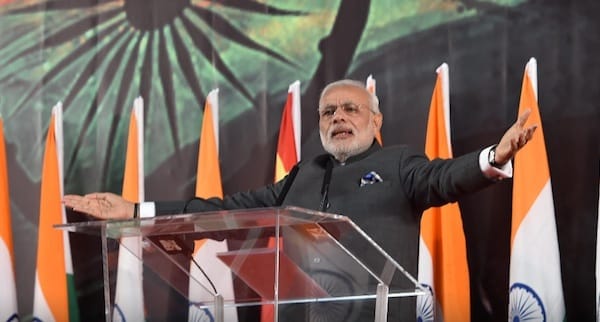India’s ‘Act East’ foreign policy under Prime Minister (PM) Modi’s administration represents a dramatic shift from the relatively passive ‘Look East’ stance that characterised the 1990s. PM Modi’s proactive efforts in reaching out to strategic regional partners, paired with his charismatic approach to foreign diplomacy, have grabbed headlines around the world. In both media and academic circles, India’s diplomatic outreach is often couched in terms of counterbalancing China. However, on a broader level, India’s recent foreign policy manoeuvres are oriented towards its domestic developmental interests and ‘great power’ ambitions. The ‘Chinese counterweight’ framework is too narrow to independently capture the multiple nuances of India’s foreign policy agenda.
It is hard to avoid perceiving India’s regional diplomacy through this ‘counterbalancing’ lens, given that its strategies in Japan and Southeast Asia may be perceived as being at loggerheads with Chinese interests.
India has taken notice of rising anti-Chinese sentiments amongst several of its neighbours. Japan’s relations with China have been strained by the ongoing territorial dispute over the Diaoyu/Senkaku Islands, and the lingering spectre of World War II history. Vietnam has seen its own friction with China over encroaching Chinese commercial interests and China’s assertive territorial claims in the South China Sea.
These developments have coincided with India strengthening its commercial, defence, and maritime partnerships with Japan and Vietnam, perhaps reflecting its attempts to leverage on the tense regional atmosphere. Notably, India has begun articulating views on maritime stability in the South China Sea, first during PM Modi’s official Washington trip last year, and subsequently at regional fora such as the East Asia Summit and India-ASEAN Summit. Although no specific country was named, PM Modi’s comments on ensuring maritime security, safeguarding freedom of navigation and implementing the maritime Code of Conduct mark a stark departure for India from its previous unaligned position. PM Modi’s clearer stance has also served as a platform to strengthen naval cooperation among players in the region. In this light, it is hardly surprising that Southeast Asian nations like Vietnam have depicted India as a potential source of regional stability.
That said, India’s renewed diplomatic engagements cannot be reduced to a one-dimensional strategy of counterbalancing China. To do so would obscure India’s broader strategic imperative of securing its own status in the region and beyond.
Turning to Sino-Indian relations, some may argue that India’s strategy has ostensibly been designed to avoid confronting China’s ascendance, perhaps seeking to preserve opportunities for cooperation. India’s ascension as a founding member of the China-initiated AIIB may be construed as accommodating China’s rising regional profile. Whether this suggests an implicit acceptance of China’s aspirations for institutionalised leadership in the region is debatable. Nonetheless, the AIIB decision attests to India’s increasingly pragmatic stance in its affairs with China. India seems to be conveying a willingness to tap on Chinese expertise in infrastructure projects to meet its own pressing domestic developmental needs.
A similar form of pragmatism could be detected in PM Modi’s visit this month to the East Asian colossus. Despite their potential adverse impact on India’s gaping trade deficits, PM Modi pushed forward with deals amounting to USD 22bn (SGD 29.65bn) with business leaders in Shanghai to enhance Indian enterprises access to capital. The agreements were established against a backdrop of limited progress on the two countries’ nagging border issue, plausibly reflecting PM Modi’s resolve to focus on mutual commercial interests. The Modi team’s dealings with their Chinese counterparts seem to underscore a firm commitment to ramping up the country’s industrialisation and employment prospects, even if doing so buttresses China’s dominant trade position and regional scope of influence.
A more integrative view of India’s ties with China and the region illuminates the multi-alignment strategy that India has pursued. This fulfils multiple purposes, allowing India to diversify its primary alliance with the US, shed its former ‘non-alignment’ stance, and cement its own role as a vital link between the East and West.
India’s ability to achieve its grand ambitions hinges on various factors, including sustained economic progress, deepening strategic partnerships and entrenching its global reputation as a thriving democracy. Appealing to the hearts and minds of the international community is a vital pillar of India’s strategic ambitions. As the South Asian giant strides confidently on to the international arena, its role in counterbalancing China may well develop as a by-product of its progress, or as a means to specific foreign policy objectives. It is clear that containing China cannot be the end-all of India’s global ambitions.
Sources:
India’s Modi visits China to boost trade ties [Wall Street Journal, 14 May 2015]
India and China sign $22bn in deals during Modi visit [Financial Times, 17 May 2015]




